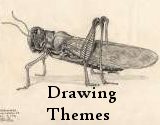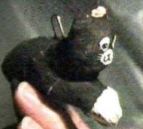Color Theory
 This
year, 2005, I am teaching high school art. On this page you will find some
of the resources that I have made for the color portion of the art
course. While it is true that the student could and probably should
draw these shapes to paint sometimes there simply isn't enough time
and that is where these printables come in.
This
year, 2005, I am teaching high school art. On this page you will find some
of the resources that I have made for the color portion of the art
course. While it is true that the student could and probably should
draw these shapes to paint sometimes there simply isn't enough time
and that is where these printables come in.
Best wishes to you and have fun teaching color theory. :-)
Supplies
- quality mixable paint in these colors: white, black, red, blue, and yellow
- paint brushes in various sizes
- paint mixing trays, water, paper towels and a protected surface for working
- paper that is paint friendly
- artist apron for each child (optional)
Color Terms:
 Hue: Pure color
without the addition of black, white, or gray
Hue: Pure color
without the addition of black, white, or gray
 Tint: Color with
white added.
Tint: Color with
white added.
 Tone: Color with
gray or its complement added.
Tone: Color with
gray or its complement added.
 Shade: Color with
black added.
Shade: Color with
black added.
 Value: The
relative darkness or lightness of a color.
Value: The
relative darkness or lightness of a color.
 Intensity:
The strength of a color, especially the degree to which it lacks its
complementary color.
Intensity:
The strength of a color, especially the degree to which it lacks its
complementary color.
 Saturation:
Vividness of hue; degree of difference from a gray of the same
lightness or brightness.
Saturation:
Vividness of hue; degree of difference from a gray of the same
lightness or brightness.
 Achromatic:
Designating color perceived to have zero saturation and therefore no
hue, such as neutral grays, white, or black.
Achromatic:
Designating color perceived to have zero saturation and therefore no
hue, such as neutral grays, white, or black.
Color Wheel Terms
 Primary Colors: Colors at their basic essence; those
colors that cannot be created by mixing others...
Primary Colors: Colors at their basic essence; those
colors that cannot be created by mixing others...
red, blue, yellow
 Secondary Colors: The colors achieved by a mixture of
two primaries...
Secondary Colors: The colors achieved by a mixture of
two primaries...
purple, orange, green
 Tertiary Colors: The colors achieved by a mixture of
primary and secondary hues..
Tertiary Colors: The colors achieved by a mixture of
primary and secondary hues..
red-orange, red-purple, blue-purple,
blue-green, yellow-green, yellow-orange
 Complementary Colors: The colors located opposite each
other on a color wheel.
Complementary Colors: The colors located opposite each
other on a color wheel.
 Analogous Colors: The colors located close together on
a color wheel and have a color in common.
Analogous Colors: The colors located close together on
a color wheel and have a color in common.
Color Schemes and Group Terms
Artists can use color groups for their palette to make a visually
pleasing color scheme.
Analogous Color Scheme uses any three
or more colors on the color wheel that have a color in common and are
adjacent on the color wheel.
See possible example: Edward Hopper - Compartment C, Car 293
Complementary Color Scheme uses colors
that are across from each other on the color wheel.
See possible example: Vincent van Gogh - Noon: Rest From Work
Monochromatic Color Scheme uses one
color and all of the tints, tones, and shades of that color. See possible example: Vincent van Gogh - Trees with ivy in the asylum garden
Triadic Colors
These are the colors that are evenly spaced on the color wheel.




Split-complementary color schemes
Split complementary is a variation of complementary.
There are 12 possible variations. In the first example below, the 3
colors connected are red, yellow-green, and blue-green. Green is the
complement of red, but in a split complementary color scheme, the
colors adjacent to the complement are used instead of the true
complement.




Warm Colors
 The colors from yellow and red-purple are usually called warm
colors.
The colors from yellow and red-purple are usually called warm
colors.
Cool Colors
 The colors from yellow-green to purple are usually called cool
colors.
The colors from yellow-green to purple are usually called cool
colors.
Artists that could be studied during a color theory class
Rembrandt (color value)
We started with Rembrandt as a opener artist. He is more commonly
known than some of the others that we will study this week.
http://www.ibiblio.org/wm/paint/auth/rembrandt/
Caravaggio (color value)
We didn't use this web page, but here is the WebMuseum Caravaggio
web page: http://www.ibiblio.org/wm/paint/auth/caravaggio/
Vincent van Gogh (color palettes)
Read about artist, look at certain paintings and tell what type of
palette was used.. (complementary colors, split-complementary,
analogous, monochromatic)
Web site linked below is a resource for paintings.
http://www.ibiblio.org/wm/paint/auth/gogh/
Edward Hopper (color palettes)
Do the same as above.
Web site linked below is a resource for paintings.
http://www.ibiblio.org/wm/paint/auth/hopper/


 Drawing in Linear Perspective
Drawing in Linear Perspective



